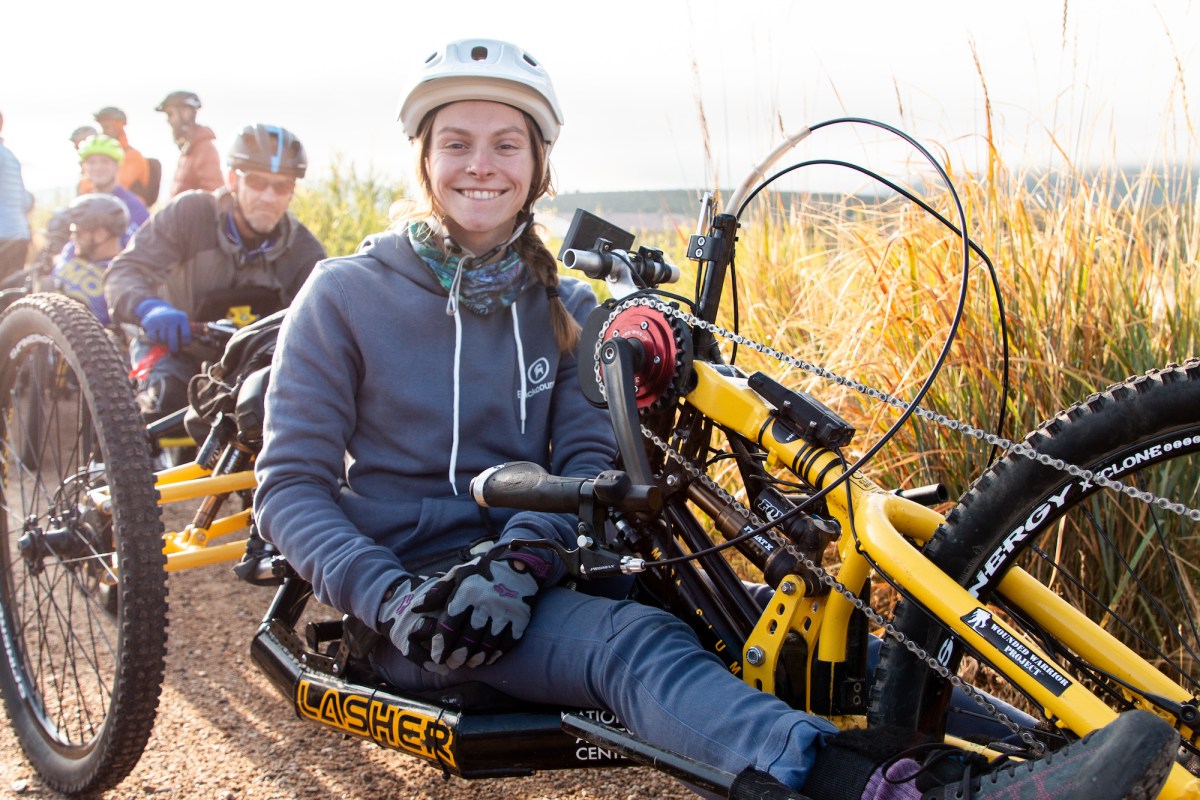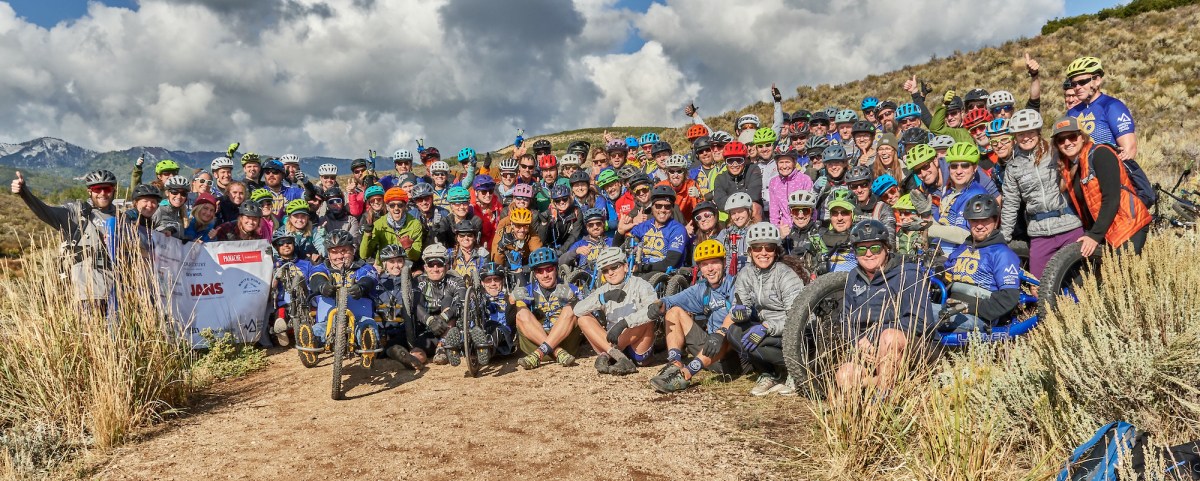Scooter, a Lab-hound mutt, was struggling to keep pace when Maggie Gettys high-sided the top of a steep, left-hand berm and landed upside down in the sagebrush. Backlit by a pink-and-gold sunset, Scooter dutifully checked on his owner and found Gettys laughing through a casual smile with no lasting damage besides a broken pair of olive-green sunglasses. “The widest part of the bike is actually the most unstable,” said Gettys, a 23-year-old graduate student and adaptive athlete. She turned her head toward me and explained that her three-wheeled handcycle is an efficient rig for munching cross-country miles, but the recumbent configuration can get a little squirrelly when speeds pick up on downhills.
“Maggie, now that you’re riding those corners faster, you need to lean more aggressively,” said Jared Dangerfield as he rode up to the crash site. Dangerfield is a bike specialist at the National Ability Center. Gettys soaked up the more educational aspects of her invert, shook off its ill effects, and went back to ripping down the trail with Scooter in tow. We were riding through the flowing Round Valley trail system in Park City, Utah, during the week leading up to Getty’s first MOFO Ride, an all-abilities mountain bike event that raises funds for the National Ability Center (NAC).
Euphemistically named after its riders, who are “tough as a …”, MOFO is the brainchild of Craig White, a volunteer and donor to the NAC, a nonprofit that empowers people of all abilities through sport, recreation and education. White conceived of the sufferfest-for-good in 2010 to help grow the NAC’s cycling program. Each year, a group of adaptive riders on handcycles and riders on traditional bicycles tackle one of several MOFO variations—the Mini MOFO, the Whole MOFO and the Adaptive MOFO. Numerous obstacles, including Puke Hill and the shorter but substantially steeper Platsen Hill, await on every route, and to raise the stakes, White pledges an additional $1,000 to the NAC cycling program for each rider who successfully summits Puke and Platsen Hills.

Maggie Gettys at the MOFO Ride. Photo Credit: Courtesy of the National Ability Center
Gettys is more than willing to take on daunting challenges like the MOFO. The North Carolina native spent her summers working as a raft guide on the Nantahala River while studying at Appalachian State University. At 19, during the summer after her sophomore year, a fall from the loft in the staff housing where Gettys lived left her with an spinal cord injury to her T11 and T12 vertebrae.
“I went straight to surgery that night at Mission Hospital in Asheville, but I don’t think I heard the word paralyzed until weeks later,” said Gettys. “Once I realized the magnitude of a spinal injury, I was so mad. Everyone asked me, ‘What instrument are you going to learn?’ My dentist actually bought me a mandolin after I mentioned I like folksy, bluegrass music. People mostly mean well, but they assume you won’t be able to do what you like anymore.”
A breakthrough came two weeks after surgery when Gettys was transferred to the Shepherd Center, a nonprofit spinal cord and brain injury rehabilitation facility in Atlanta, Georgia. In addition to receiving physical therapy and occupational therapy, Gettys worked with a recreational therapist who was the first person to ask her what she liked to do. “So much of my life was centered around being in the outdoors, and I wasn’t ready to let that go,” said Gettys.
Three months after her injury, Gettys was already getting back to being in the outdoors. She started climbing, then skiing and eventually biking. Her first mountain bike ride was in Brevard County, North Carolina. In a prone position aboard an offroad handcycle, Gettys tore down tacky dirt trails under the thick green canopy of DuPont State Forest.
“I instantly fell in love,” she said. “Getting to the top, I had this huge sense of accomplishment. Then going downhill was so engaging, dynamic and thrilling. In that moment, I didn’t think about anything other than what I was doing. All the struggle felt worth it.”
Gettys moved across the country to Salt Lake City last spring, where she has gotten involved with the National Ability Center. She’s the only woman enrolled in a three-day training camp leading up to the MOFO ride. Under an unusually hot late-summer sun, riders climbed twisting singletrack through a sea of sagebrush toward the top of Pulp Friction. One by one, riders dropped into to the trail. About halfway down, Gettys rode up beaming.
“I fell again, but I made it past the spot that got me last time,” she said, before continuing her ride along an off-camber traverse with substantial exposure. Upon reaching the trailhead at the bottom, she proudly held up one of the pedal handles from her handcycle that she accidentally tore off the crank while descending. “Sorry to make some extra work for you, Jared,” she said without a hint of regret.
Finicky mountain weather impacted the remainder of the camp. The highly-anticipated downhill shuttle day at Deer Valley Bike Park was canceled when a September snowstorm blew through. Saturday’s MOFO routes were altered in the wake of the storm. But the weather wasn’t going to derail a group as unflinching as the MOFO riders. Platsen and Puke Hills were off the menu, but in its place 72 riders tackled a replacement hill climb.

Photo Credit: Courtesy of the National Ability Center
Post MOFO, everyone gathered at the NAC for a banquet and after-party. During the festivities, Gettys was announced as the NAC Adaptive Athlete of the Year, much to her surprise. The reward? A free trip to Moab, Utah, to ride the White Rim Trail.
Five days later, Gettys found herself gripping the bars on the back of a tandem mountain bike piloted by NAC Program Manager Steph Meyer. While she navigated tight switchbacks and repeated rollers and compressions on a loose trail atop an exceedingly unstable rig, Gettys was also interviewing for a job as a recreation instructor at the NAC. After she got back, she said the interview went well. “It takes a lot of trust when you’re on the back of that bike,” said Gettys. “My legs were so tired, too.”
She was right. Gettys will join the NAC this winter. “While volunteering recently, I got to work with an 11-year-old who has cerebral palsy,” she said. “Just talking to him about the adaptive equipment and comparing our braces and seeing him smile and laugh was incredible. I’m looking forward to being able to help more instead of just being the participant myself.”
